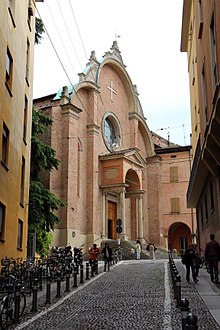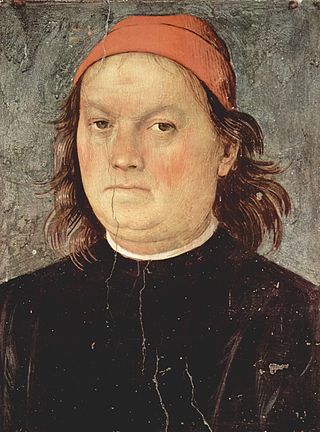
San Giovanni in Monte is a 15th-century Roman Catholic church in Bologna, Italy.

San Giovanni in Monte is a 15th-century Roman Catholic church in Bologna, Italy.
The current church can be traced back to a round church from the 5th century known as the Monte Oliveto, traditionally said to be founded by Saint Petronius in 433. [1] The first written mention of the church dates from 1045. [2] In or before 1118, the Canons Regular of the Lateran established a community here, which first restored and enlarged the old church (between ca. 1200 and ca. 1300) and replaced it with a new, late Gothic church (ca. 1450), with a 1474 facade in Renaissance style. [3] The vault was finally finished in 1603. The bell tower is over 40m high. It was finished in the 14th century, with a base dating back to the 13th century. [2]
The canons regular were expelled after Napoleon invaded Italy, and some of the artworks from the church were moved to the Louvre. After the defeat of Napoleon, most of the artworks returned, but some were moved to Italian museums instead. In 1824, the floor of the church was replaced; the tombstones that were placed until then in the floor were moved to the walls at that time. [2]
On 29 January 1944, the church was badly damaged after a bombing raid, with three chapels destroyed and considerable damage to the portico, the vault, and other chapels. The church was restored between 1947 and 1950. [2]

The portico has a large sculpture of an eagle (the symbol of John the Evangelist, patron saint of the church) by Niccolò dell'Arca (ca. 1481).
The altar is Pre-Romanesque and Romanesque, with the octagonal columns and the cross dating back to the 11th century and earlier. The Christ on the cross is a 16th-century wooden sculpture. [2]
The interior had work by Cima da Conegliano, the Madonna of the Rosary by Domenichino, the Madonna with St. Michael and three other Saints by Pietro Perugino, and The Ecstasy of St. Cecilia by Raphael (the original was commissioned for the San Giovanni in 1513). These pictures were removed during Napoleonic times and can now be found in the Pinacoteca Nazionale di Bologna. [3] [2]
In the "Cappella Maggiore" or Major Chapel are a painting by father Petronius Fancelli and son Pietro Fancelli, a crucifix by Jacopino da Bologna from 1361, a painting by Cesare Aretusi and Giovanni Battista Fiorini, and a choir with 53 seats, carved by Paolo Sacca, an artist from Cremona, between 1518 and 1523. Until 1752, it housed a Predella polyptych by Ercole de' Roberti, parts of which are now in Dresden and parts in Liverpool. The sacristy has as altar piece a Saint Patrick by Vincenzo Spisanelli and paintings by Felice Torelli, Ercole Graziani the Younger, Ubaldo Gandolfi and Prospero Fontana. [2]
In the chapels around the church are further paintings by mainly Bolognese artists like Lorenzo Costa, Ercole Procaccini the Elder, Giacomo Francia, Bartolomeo Cesi, Benedetto Gennari, Orazio Samacchini, Alessandro Tiarini, Francesco del Cossa, Giovanni Battista Bolognini, Luca Longhi and Pietro Faccini, further works by Spisanelli, 15th-century frescoes by Giovanni da Modena, and a 15th-century Pietà. Chapel XVI contains a Saint Francis of Assisi by Guercino from 1645.
Other works of art include the 15th-century stained glass windows designed by Lorenzo Costa and Francesco del Cossa, an altar-piece from the 14th century, and frescoes by the brothers Giulio and Giacomo Raibolini, which were only rediscovered in 1894. [3] [2]

Pietro Perugino, an Italian Renaissance painter of the Umbrian school, developed some of the qualities that found classic expression in the High Renaissance. Raphael became his most famous pupil.

Lo Spagna, "the Spaniard" in Italian, was a painter of the High Renaissance, active in central Italy. His name was Giovanni di Pietro, but he was known as Lo Spagna because he was born in Spain. After Raphael, he was a main pupil and follower of the Umbrian painter Perugino, whose style his paintings developed. He should not be confused with Pietro di Giovanni D'Ambrogio of Siena.

Giacomo Cavedone was an Italian Baroque painter of the Bolognese School.

Francesco del Cossa was an Italian Renaissance painter of the School of Ferrara, who after 1470 worked in Bologna. Cossa is best known for his frescoes, especially his collaboration with Cosimo Tura on a cycle of the months in the Palazzo Schifanoia of the Este family, rulers of Ferrara. Otherwise, his paintings are mostly of religious subjects, with some portraits and drawings attributed to him. He also designed stained glass.

The Basilica of San Petronio is a minor basilica and church of the Archdiocese of Bologna located in Bologna, Emilia Romagna, northern Italy. It dominates Piazza Maggiore. The basilica is dedicated to the patron saint of the city, Saint Petronius, who was the Bishop of Bologna in the fifth century. Construction began in 1390 and its main facade has remained unfinished since. The building was transferred from the city to the diocese in 1929; the basilica was finally consecrated in 1954. It has been the seat of the relics of Bologna's patron saint only since 2000; until then, they were preserved in the Santo Stefano church.

The basilica diSan Pietro is a Catholic basilica and abbey in the Italian city of Perugia. Its bell tower, standing at 70 meters tall, is the tallest structure in Perugia and is one of the city's most significant symbols. It is an Italian national monument

The Basilica of San Domenico is one of the major churches in Bologna, Italy. The remains of Saint Dominic, founder of the Order of Preachers (Dominicans), are buried inside the exquisite shrine Arca di San Domenico, made by Nicola Pisano and his workshop, Arnolfo di Cambio and with later additions by Niccolò dell'Arca and the young Michelangelo.

Palazzo dei Diamanti is a Renaissance palace located on Corso Ercole I d'Este 21 in Ferrara, region of Emilia Romagna, Italy. The main floor of the Palace houses the Pinacoteca Nazionale di Ferrara.

Lorenzo di Niccolò or Lorenzo di Niccolò di Martino was an Italian painter who was active in Florence from 1391 to 1412. This early Renaissance artist worked in the Trecento style, and his work maintains influences of the Gothic style, marking a transitional period between the Gothic sensibilities of the Middle Ages while simultaneously beginning to draw on the Classical. Lorenzo's works were usually religious scenes in tempera with gold backgrounds.

San Nicola da Tolentino agli Orti Sallustiani is a church in Rome. It is referred to in both Melchiori's and Venuti's guides as San Niccolò di Tolentino, and in the latter it adds the suffix a Capo le Case. It is one of the two Roman national churches of Armenia. The church was built for the Discalced Augustinians in 1599, and originally dedicated to the 13th century Augustinian friar Saint Nicholas of Tolentino.

Ercole de' Roberti, also known as Ercole Ferrarese or Ercole da Ferrara, was an Italian artist of the Early Renaissance and the School of Ferrara. He was profiled in Vasari's Le Vite delle più eccellenti pittori, scultori, ed architettori. The son of the doorkeeper at the Este castle, Ercole later held the position of court artist for the Este family in Ferrara. According to Vasari:
Ercole had an extraordinary love of wine, and his frequent drunkenness did much to shorten his life, which he had enjoyed without any accident up to the age of forty, when he was smitten one day by apoplexy, which made an end of him in a short time.

Perugia Cathedral, officially the Metropolitan Cathedral of St. Lawrence, is a Roman Catholic cathedral in Perugia, Umbria, central Italy, dedicated to Saint Lawrence. Formerly the seat of the bishops and archbishops of Perugia, it has been since 1986 the archiepiscopal seat of the Archdiocese of Perugia-Città della Pieve.

Biagio d’Antonio Tucci was an Italian Renaissance painter active in Florence, Faenza and Rome.

The National Art Gallery of Bologna is a museum in Bologna, Italy. It is located in the former Saint Ignatius Jesuit novitiate of the city's University district, and inside the same building that houses the Academy of Fine Arts. The museum offers a wide collection of Emilian paintings from the 13th to the 18th century and other fundamental works by artists who were in some way related to the city.

The Madonna and Child Enthroned with Saints John the Baptist and Sebastian is a painting by the Italian Renaissance artist Pietro Perugino, executed in 1493 and housed in the Uffizi Gallery, Florence.

The Madonna in Glory with Saints is a painting by the Italian Renaissance painter Pietro Perugino, dating to c. 1500–1501. It is housed in the Pinacoteca Nazionale of Bologna, Italy.

San Procolo is an early Gothic-style, Roman Catholic church and former monastery-hospital located on Via Massimo D'Azeglio #52 in central Bologna, region of Emilia Romagna, Italy.

Andrea di Niccolò, also Andrea di Niccolò di Giacomo, (1440–1514) was an Italian painter of the Sienese School.

The Pinacotecta Nazionale is an art gallery in Ferrara, Emilia-Romagna, Italy. It is located on the piano nobile of the Palazzo dei Diamanti, a work of Renaissance architecture by Biagio Rossetti, commissioned by Leonello d’Este in 1447. Not to be confused with the Civic Museum on the lower floor, which has hosted temporary exhibitions of contemporary art since 1992, the Pinacoteca houses a collection of paintings by the Ferrarese School dating from the thirteenth to the eighteenth centuries. It was founded in 1836 by the Municipality of Ferrara after Napoleon's widespread dissolution of churches threatened the protection of important public artworks. The gallery is formed as much around notable northern Italian painters as it is around the exquisite interior decoration of the palace itself, together with remnants of frescoes from local churches and later acquisitions from the Sacrati Strozzi collection.

Crucifixion with Saints or Crucifixion with Mourners and Saints Bernardino of Siena, Francis of Assisi and Petronius is a 1583 oil on canvas, now in the church of Santa Maria della Carità in Bologna. The work was originally sited in the Macchiavelli chapel in San Nicolò di San Felice, Bologna, next to Santa Maria della Carità, which was destroyed by bombing during the Second World War. It was then temporarily moved to the Soprintendenza di Bologna and finally to its current home.